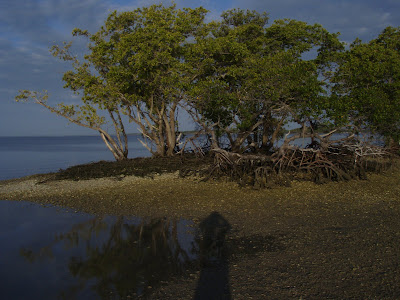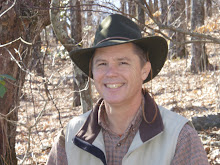While we are never really certain of what our Creator will show us on any particular trip, some of the things we remember about this one were the unbelievably fantastic weather, the manatee swimming right up under one of our canoes, the ospreys warning us away from their nest, the porpoises racing in circles around us and then jumping for the sky, sand bars with so many fiddler crabs that the entire surface seemed to move, a bull shark sharing a quiet cove with us, colorful sunrises and sunsets, pelicans everywhere, sandbars covered with birds and sandy beaches with nothing but the finest white powder sand, mangrove trees growing so close that even the fish and crabs sometimes had trouble working their way out, sea shells everywhere we turned, ducks, cormorants, egrets, herons, and many more birds that we are still trying to identify.

Osprey were seen tending their young, catching fish and rodents, and flying high overhead as we traveled the Blackwater River out to the Gulf. Nests were built on signposts and treetops; wherever they felt they could be safe and see the approach of any possible danger. The Bible tells us to soar like the eagle and it's no wonder why these big raptors are often mistaken for just that.

Birds of a feather usually flock together but there were those rare occasions where pelicans and cormorants would share the same roost.

We couldn't escape the watchful eye of this pelican as he allowed us to scare up a meal or two for him in the protected lagoon he seemed to prefer.

We launched from Collier-Seminole State Park, located on Royal Palm Hammock, which is the site of the largest grove of native Royal Palms in the country.

The porpoises seemed to enjoy playing with us as they would sneak up and surprise us by blowing air and making sounds that reminded us of a horse's snort. Several even performed some aerial maneuvers such as high jumps, flips, and their own version of the belly flop.

Royal Palms are known for their distinctive green headstalks and consistently shaped tops.

These red mangrove trees were right in front of our base camp location and provided a great example of how the 10,000 Islands are continuing to form with each passing year.

Here is a view of the same trees from my tent at low tide with the customary orange Florida sunset.

This photo shows just how clear the water in the 10,000 Islands and Rookery Bay area can be. It has the same appearance as some of the springfed freshwater Florida streams.

One last shot as we finished taking down the tents and packing for the paddle back home. Beach camping just doesn't get any better than this!

We had a driftwood fire to sit around each night and discuss all the days sights and lessons.

On the way past Turtle Key, I shot this photo of side-by-side black (on the left) and red mangrove trees. Notice that the red mangrove has the distinctive prop roots whereas the black mangrove has smaller air roots somewhat like the cypress knees we were more familiar with.
God has done some amazing work in sculpturing landforms in the area, both for our delight and for our challenge. This sandbar was about 1/2 mile long and the tide was still over two hours away from complete low tide. Rather than portage the fully loaded canoes over the rough sand and shells, we elected to explore another hidden bay in search of a short cut. It was shorter but, in the process, we ended up paddling in about 5" of water over some very sticky mud for about an hour.





No comments:
Post a Comment